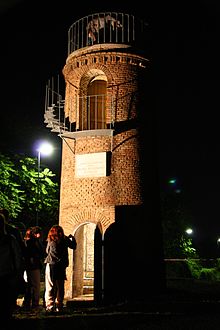Meridian of Rome
The Meridian of Rome was before the International Meridian Conference defined 1884 prime meridian , the only in Italy was used. It is 12 ° 27 ′ 08,400 ″ east of the Greenwich meridian . The meridian of Rome runs through the Torre del Meridiano of the Osservatorio Astronomico di Roma on Monte Mario in Rome.
history
The meridian of Rome was established in the year of the unification of Italy in 1870 by the Jesuit priest and astronomer Angelo Secchi . Monte Mario was chosen as the central geodetic point , where construction of an eight-meter-high tower began that same year. After the Papal States had been eliminated by the Kingdom of Italy in September 1870, the latter continued the project and completed construction in 1871. Because of the construction of Forte Monte Mario , the tower was demolished in 1877 and then rebuilt in the same place from 1882. From 1872 onwards, all maps of the Military Geographic Institute were based on the meridian of Rome. In October 1884, Italy voted for the Greenwich Meridian at the International Meridian Conference, but continued to use the Rome meridian predominantly. The Military Geography Institute only gave up this between 1964 and 1974.
Course of the meridian
In Italy, the meridian runs from the Kreuzberg Pass over the Venetian lagoon ( Burano ), the Po Delta and the Rubicon to Rome, where it runs over Monte Mario and through the Vatican Gardens . In Torvajanica near Pomezia it leaves the Lazio coast , crosses the Tyrrhenian Sea , then the western tip of Sicily at Marsala , the Strait of Sicily and finally runs west of Lampedusa in the direction of Sabrata .
Web links
- Meridian of Rome on studiumurbis.org (English)
Coordinates: 41 ° 55 ′ 27.9 ″ N , 12 ° 27 ′ 7.7 ″ E
